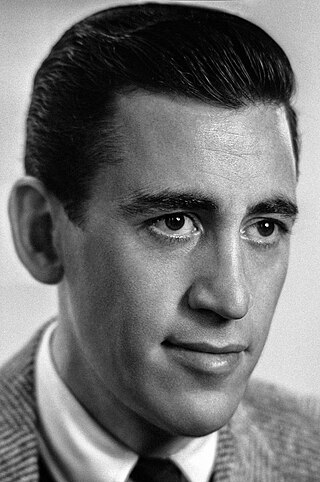The Catcher in the Rye is a novel by American author J. D. Salinger that was partially published in serial form in 1945–46 before being novelized in 1951. Originally intended for adults, it is often read by adolescents for its themes of angst and alienation, and as a critique of superficiality in society. The novel also deals with themes of innocence, identity, belonging, loss, connection, sex, and depression. The main character, Holden Caulfield, has become an icon for teenage rebellion. Caulfield, nearly of age, gives his opinion on a wide variety of topics as he narrates his recent life events.

Holden Caulfield is a fictional character in the works of author J. D. Salinger. He is most famous for his appearance as the lead character and narrator of the 1951 novel The Catcher in the Rye. Since the book's publication, Holden has become an icon for teenage rebellion and angst, and is considered among the most important characters of 20th-century American literature. The name Holden Caulfield was initially used in an unpublished short story written in 1941 and first appeared in print in 1945.
"The Ocean Full of Bowling Balls" is an unpublished work by J. D. Salinger. It is about the death of Kenneth Caulfield, who later became the character Allie in The Catcher in the Rye.
“Slight Rebellion off Madison” is an uncollected work of short fiction by J. D. Salinger which appeared in the 21 December 1946 issue of The New Yorker.

Shoeless Joe is a 1982 magic realist novel by Canadian author W. P. Kinsella that was later adapted into the 1989 film Field of Dreams, which was nominated for three Academy Awards.
"I'm Crazy" is a short story written by J. D. Salinger for the December 22, 1945 issue of Collier's magazine. Despite the story's underlying melancholy, the magazine described it as "the heart-warming story of a kid whose only fault lay in understanding people so well that most of them were baffled by him and only a very few would believe in him".
“A Boy in France” is an uncollected work of short fiction by J. D. Salinger which appeared in the 31 March 1945 issue of The Saturday Evening Post.
The 1951 novel The Catcher in the Rye by J. D. Salinger has had a lasting influence as it remains both a bestseller and a frequently challenged book. Numerous works in popular culture have referenced the novel. Factors contributing to the novel's mystique and impact include its portrayal of protagonist Holden Caulfield; its tone of sincerity; its themes of familial neglect, tension between teens and society, and rebellion; its previous banned status; and Salinger's reclusiveness. The Catcher in the Rye has inspired "rewrites" which have been said to form their own genre. On the other hand, there are examples of similarities between the novel and other works that were not intended by their authors, which suggests that the novel is "present, at least spiritually, in ... any story line that involves quirky young people struggling to find their places in a society prone to reward conformity and condemn individuality."
“The Varioni Brothers” is an uncollected work of short fiction by J. D. Salinger which appeared in the 17 July, 1943 issue of The Saturday Evening Post.
“Both Parties Concerned” is an uncollected work of short fiction by J. D. Salinger which appeared in the 26 February, 1944 issue of The Saturday Evening Post.
“Soft-Boiled Sergeant” is an uncollected work of short fiction by J. D. Salinger which appeared in the 15 April 1944 issue of The Saturday Evening Post. The story was illustrated by Graham Kaye..
"The Stranger" is a short story written by J. D. Salinger first published in the December 1, 1945 issue of Collier's magazine.
“Elaine” is an uncollected work of short fiction by J. D. Salinger which appeared in the March-April, 1945 issue of Story.
"A Young Girl in 1941 with No Waist at All" is a short story by J. D. Salinger, published in Mademoiselle in May 1947. The story has not been published in any authorized anthology, but has appeared in the 1974 unauthorized collection Twenty-one Stories: The Complete Uncollected Short Stories of J. D. Salinger. The illustrator was Laura Jean Allen. The character of Ray Kinsella is seen as an early version of the character Seymour from Salinger's later work "A Perfect Day for Bananafish".
"This Sandwich Has No Mayonnaise" is an uncollected work of short fiction by J. D. Salinger which appeared in the October 1945 issue of Esquire. The story was published in the 1958 anthology The Armchair Esquire, edited by Arnold Gingrich and L. Rust Hills.

Jerome David Salinger was an American author best known for his 1951 novel The Catcher in the Rye. Salinger published several short stories in Story magazine in 1940, before serving in World War II. In 1948, his critically acclaimed story "A Perfect Day for Bananafish" appeared in The New Yorker, which published much of his later work.
“A Girl I Knew” is an uncollected work of short fiction by J. D. Salinger which appeared in the February 1948 issue of Good Housekeeping.
"The Last and Best of the Peter Pans" is an unpublished short story by J. D. Salinger.
“The Children’s Echelon” is an unpublished work of short fiction by J. D. Salinger written in 1944 when the author was serving in combat during World War II. The work was referred to as both “The Children’s Echelon” and “Total War Diary” in Salinger’s professional correspondence. It can be located in the Firestone Library in Princeton University.

Neither Salinger in his lifetime nor his estate after his death has ever authorized the publication of a volume of Salinger's registered early short fiction which appeared in magazines between 1940 and 1965. Reprints of his early stories have appeared under the auspices of Esquire and The New Yorker, to which Salinger stories had originally been sold.



